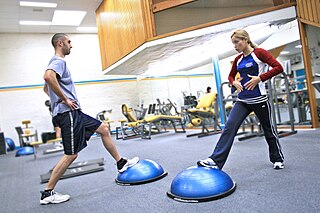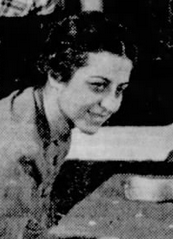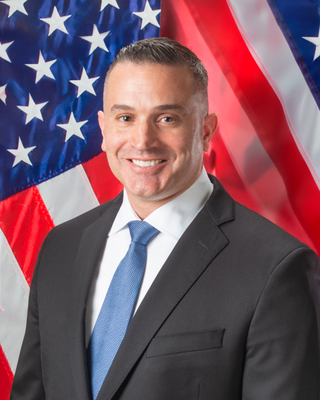
A personal trainer is an individual who creates and delivers safe and effective exercise programs for healthy individuals and groups, or those with medical clearance to exercise. They motivate clients by collaborating to set goals, providing meaningful feedback, and by being a reliable source for accountability. Trainers also conduct a variety of assessments beginning with a preparticipation health-screening and may also include assessments of posture and movement, flexibility, balance, core function, cardio-respiratory fitness, muscular fitness, body composition, and skill-related parameters to observe and gather relevant information needed to develop an effective exercise program and support client goal attainment.

A cardiac stress test is a cardiological examination that evaluates the cardiovascular system's response to external stress within a controlled clinical setting. This stress response can be induced through physical exercise or intravenous pharmacological stimulation of heart rate.

Sports science is a discipline that studies how the healthy human body works during exercise, and how sport and physical activity promote health and performance from cellular to whole body perspectives. The study of sports science traditionally incorporates areas of physiology, psychology, anatomy, biomechanics, biochemistry, and kinesiology.

Sports medicine is a branch of medicine that deals with physical fitness and the treatment and prevention of injuries related to sports and exercise. Although most sports teams have employed team physicians for many years, it is only since the late 20th century that sports medicine emerged as a distinct field of health care. In some countries, sports medicine is a recognized medical specialty. In the majority of countries where sports medicine is recognized and practiced, it is a physician (non-surgical) specialty, but in some, it can equally be a surgical or non-surgical medical specialty, and also a specialty field within primary care. In other contexts, the field of sports medicine encompasses the scope of both medical specialists as well as allied health practitioners who work in the field of sport, such as physiotherapists, athletic trainers, podiatrists and exercise physiologists.
Circuit training is a form of body conditioning that involves endurance training, resistance training, high-intensity aerobics, and exercises performed in a circuit, similar to high-intensity interval training. It targets strength building and muscular endurance. An exercise "circuit" is one completion of all set exercises in the program. When one circuit is completed, one begins the first exercise again for the next circuit. Traditionally, the time between exercises in circuit training is short and often with rapid movement to the next exercise.
Exercise is Medicine (EIM) is a nonprofit initiative co-launched on November 5, 2007, by the American College of Sports Medicine and the American Medical Association, with support from the Office of the Surgeon General and the 18th Surgeon General Regina Benjamin.
The American Society of Exercise Physiologists is a non-profit professional organization for exercise physiologists. Founded in Minnesota in 1997, its vision is to establish board-certified exercise physiologists as experts in the application of "exercise as medicine" to benefit society. As the scientific body of exercise physiology has some overlap with athletics and sports training, the organization advocates for the unique contributions of exercise physiologists and attempts to enhance their public sector job opportunities.
Exercise prescription commonly refers to the specific plan of fitness-related activities that are designed for a specified purpose, which is often developed by a fitness or rehabilitation, or Exercise medicine specialist for the client or patient. Due to the specific and unique needs and interests of the client/patient, the goal of exercise prescription should focus on motivation and customization, thus making achieving goals more likely to become successful. Exercise prescription should take into account the patient's medical history, and a pre-examination of a patient's physical fitness to make sure a person has the capacity to perform the exercises.

A professional fitness coach is a professional in the field of fitness and exercise, most often instruction, including professional sports club's fitness trainers and aerobics and yoga instructors and authors of fitness instruction books or manuals.
Ulrik Wisløf is a Norwegian researcher, a professor and an entrepreneur in the field of exercise physiology, and the Head of the Cardiac Exercise Research Group (ntnu.edu/cerg) at the Dept. of Circulation and Medical Imaging, Norwegian University of Science and Technology, and he is also a Honorary Professor at University of Queensland Australia. He was appointed professor in 2008 and quickly built up an international, transdisciplinary and competitive group, as documented by >280 peer-reviewed publications and ~72 000 citations. According to Google Scholar, he figures among the world's 4 most cited scientists in the broad field of “exercise” and the most cited Exercise Physiologist worldwide. Many of his publications demonstrate his group's capacity to translate basic experimental research into clinical use in a short timeframe. He has served as PI of several successful national and international collaborations, demonstrating scientific leadership. He is working on projects related to optimising the benefits of exercise training in health and disease and utilising technologies to improve adherence to exercise training. Wisløff and colleagues provided the first causative evidence that low exercise capacity per se dramatically increased risk of heart disease. The study published in Science in 2005, with commentary in Nature Medicine, was ranked as one of the most important papers in the metabolism field at the time. They subsequently showed that high-intensity exercise training was safe and lead to superior improvements in aerobic capacity (fitness) and cardiac function in heart failure patients. This line of research formed the basis for his research group; with later studies showing optimal results with high intensity exercise in various lifestyle related disorders. They revealed that temporal changes in resting heart rate predict death from heart disease in the general population. This led to creation of a calculator to estimate fitness and so predict death in the general population. The calculator is free and available on the web and all app stores. To date 9.5 million users have used the fitness calculator; they also agreed to share their data in research. The American Heart Association now advocates the use of their fitness calculator in clinical practice. Wisløff is also the inventor of the Personalized Activity Intelligence (PAI); a metric that calculates how much physical activity a person needs to be protected against life-style related disease and premature death. The PAI app is free and available in all app stores. Wisløff's group has translated basic experimental evidence into clinical trials within a remarkably short timeframe, with research spanning from molecules to society, and back again. His record of accomplishment demonstrates leadership, capability and innovation required to perform ground-breaking research. Wisløff is also a committed mentor who actively supports next-generation scientists, and have personally supervised 22 postdoctoral fellows and 38 PhD students, who have gone on to have successful careers in both industry and academia. In February 2020 professor Ulrik Wisloff was awarded the Norwegian Health Association's Heart Research Award. The price was handed over by the King of Norway.
Medicine & Science in Sports & Exercise is a monthly peer-reviewed that focuses on research in the field of sports and exercise science. It was established in 1969 and is published by Lippincott Williams & Wilkins on behalf of the American College of Sports Medicine. The editor-in-chief is Andrew (Andy) Jones, Ph.D., FACSM.

The SUNY Downstate Health Sciences University is a public medical school in New York City and one of the three components of SUNY Downstate Health Sciences University: University Hospital at Long Island College Hospital, SUNY Downstate at Bay Ridge, and University Hospital of Brooklyn in East Flatbush, whose staffing is provided by SUNY Downstate College of Medicine.

Exercise and Sport Sciences Reviews is a quarterly peer-reviewed review journal covering sports medicine and exercise science. It was established in 1973 as a hardcover book series, and became a quarterly peer-reviewed journal in January 2000. It is published by Lippincott Williams & Wilkins, and is an official journal of the American College of Sports Medicine. The editor-in-chief is Sandra K. Hunter, Ph.D., FACSM. According to the Journal Citation Reports, the journal has a 2021 impact factor of 6.642.
Michael Joseph Joyner is an American anesthesiologist and physiologist who researches exercise physiology.

Josephine Langworthy Rathbone was an American physiologist whose research and work involved physical education and relaxation. She taught at Teachers College, Columbia University from 1930 to 1958, and was a founding member of the American College of Sports Medicine (ACSM).
Mary Kathryn "Katie" Haltiwanger Schmitz is an American exercise physiologist. She is the Associate Director of Population Sciences at Penn State University College of Medicine and a Full Professor at the Perelman School of Medicine at the University of Pennsylvania.

David Christopher Poole is a British-American scientist who researches oxygen transport in health and disease focusing on the mechanisms of exercise intolerance.

Stefan M. Pasiakos is a U.S. physiologist specializing in diet and supplemental nutrition, muscle physiology, and human performance. He has served as the director of the National Institutes of Health (NIH) office of dietary supplements since 2023. Pasiakos was previously chief of the military performance division at the United States Army Research Institute of Environmental Medicine.
Barbara Lee Drinkwater was an American physiologist who specialized in sports physiology and was the first woman to be president of the American College of Sports Medicine (1988–1989). Prior to that, she also coached the Butler Bulldogs women's basketball team.










